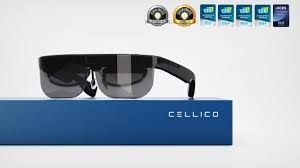Age-related macular degeneration (AMD) is a leading cause of vision loss among individuals over 60, significantly impacting daily activities such as reading, driving, and recognizing faces. As the global population ages, the prevalence of AMD is expected to rise, highlighting the urgent need for effective interventions. Recent advancements in augmented reality (AR) technology have introduced innovative solutions aimed at enhancing the quality of life for those affected by AMD. One such groundbreaking development is EyeCane, an AR-based device developed by Cellico, designed specifically to assist individuals experiencing vision loss due to AMD.
Understanding Age-Related Macular Degeneration
AMD is characterized by the deterioration of the macula, the central portion of the retina responsible for sharp, central vision. This degeneration leads to blurred or distorted central vision, while peripheral vision often remains unaffected. The disease manifests in two primary forms:
-
Dry AMD: This more common form accounts for approximately 80-90% of cases and involves the gradual breakdown of light-sensitive cells in the macula, accompanied by the accumulation of drusen—yellow deposits beneath the retina.
-
Wet AMD: Although less prevalent, wet AMD is more severe and is characterized by the growth of abnormal blood vessels beneath the retina, leading to leakage of blood and fluid, which can cause rapid and significant vision loss.
Risk factors for AMD include advancing age, genetic predisposition, smoking, high blood pressure, and diets high in saturated fats. Early detection through regular eye examinations is crucial, as interventions can slow disease progression and mitigate vision loss.
The Role of Augmented Reality in Vision Rehabilitation
Augmented reality technology superimposes digital information onto the real-world environment, enhancing the user's perception and interaction with their surroundings. In the context of vision rehabilitation, AR offers promising avenues by providing real-time visual enhancements, object recognition, and navigational assistance. For individuals with AMD, AR can compensate for central vision loss by projecting critical visual information onto the functional areas of the retina, thereby improving the ability to perform daily activities independently.
Introducing EyeCane by Cellico
Cellico, a high-tech startup specializing in visual aid technologies, has developed EyeCane, a pair of smart glasses designed to assist individuals suffering from AMD. These AR glasses aim to enhance visual perception by utilizing a 4K camera to capture the user's environment and process visual information in real-time. The processed images are then projected onto the user's peripheral vision, effectively bypassing the damaged central macula and leveraging the healthier parts of the retina.
Key Features of EyeCane
-
Real-Time Image Processing: The 4K camera captures high-resolution images, which are processed instantaneously to provide users with an enhanced visual experience.
-
Customizable Visual Settings: Users can adjust contrast, brightness, and magnification levels to suit their specific visual needs, allowing for a personalized experience.
-
Object and Text Recognition: EyeCane is equipped with advanced algorithms capable of recognizing objects and text within the environment, aiding users in identifying faces, reading signs, and navigating complex spaces.
-
Lightweight and Ergonomic Design: Designed with user comfort in mind, EyeCane features a lightweight frame that can be worn for extended periods without discomfort.
Clinical Implications and User Benefits
The introduction of EyeCane into the realm of vision rehabilitation presents several potential benefits for individuals with AMD:
-
Enhanced Independence: By improving the ability to perceive and interpret visual information, users may regain the confidence to perform daily tasks without reliance on assistance.
-
Improved Safety: Enhanced environmental awareness can reduce the risk of accidents and injuries, particularly in unfamiliar or complex settings.
-
Psychological Well-being: Regaining visual function can have a positive impact on mental health, reducing feelings of isolation and depression commonly associated with vision loss.
Comparative Analysis with Other AR Solutions
While EyeCane represents a significant advancement in AR-based vision aids, it is part of a broader landscape of technological innovations aimed at assisting individuals with visual impairments. For instance, devices like OcuLenz by Ocutrx Technologies offer similar AR solutions tailored for AMD patients. OcuLenz utilizes real-time video imagery to enhance visual clarity, providing features such as high-contrast overlays and customizable settings. Both devices share the common goal of leveraging AR to compensate for central vision loss, though differences may exist in design, user interface, and specific functionalities.
Challenges and Considerations
Despite the promising potential of AR devices like EyeCane, several challenges must be addressed to ensure their widespread adoption and effectiveness:
-
Accessibility and Affordability: The cost of advanced AR devices may be prohibitive for some individuals. Efforts to secure insurance coverage and develop cost-effective models are essential to enhance accessibility.
-
User Training and Adaptation: Effective use of AR devices requires adequate training and an adaptation period. Providing comprehensive user education and support is crucial for maximizing benefits.
-
Technological Limitations: Continuous improvements in hardware and software are necessary to enhance the performance, reliability, and user-friendliness of AR vision aids.
Conclusion
The emergence of augmented reality technologies like EyeCane by Cellico offers a beacon of hope for individuals affected by age-related macular degeneration. By harnessing the power of AR to enhance visual perception, these devices have the potential to restore a degree of independence and improve the quality of life for those experiencing central vision loss. As research and development in this field continue to advance, it is anticipated that AR-based solutions will become increasingly integral to vision rehabilitation strategies, providing innovative and effective support for individuals with AMD.





